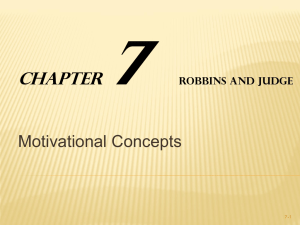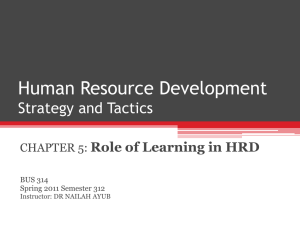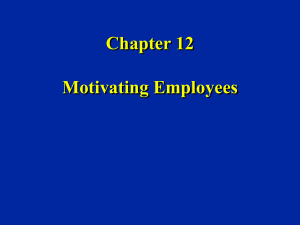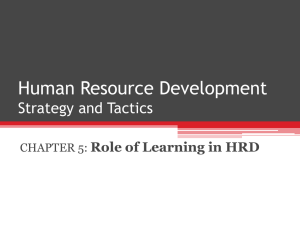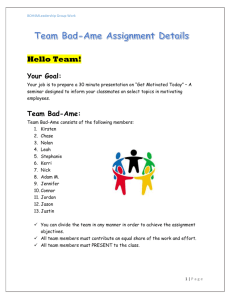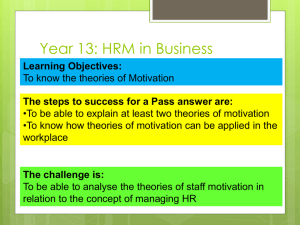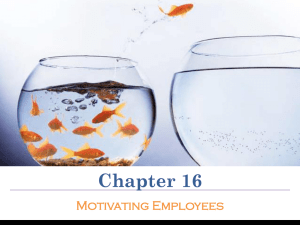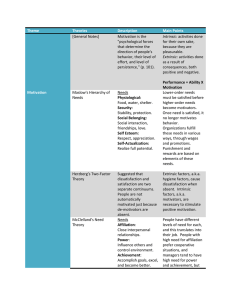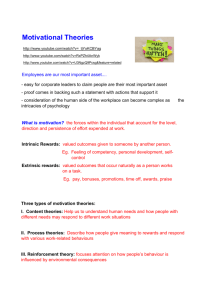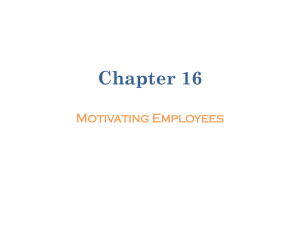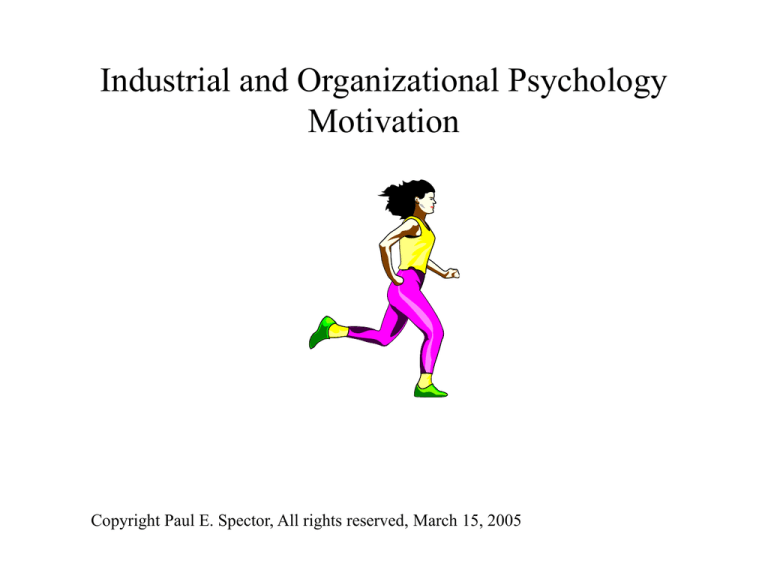
Industrial and Organizational Psychology
Motivation
Copyright Paul E. Spector, All rights reserved, March 15, 2005
What Is Motivation?
• Internal regulatory processes of behavior
– Direction: What should I do?
– Intensity: How hard should I try?
– Persistence: Should I keep going?
•
Distal
– Processes far removed from the actual behavior
– Needs—what I want but not how I will get it.
•
Proximal
– Processes close to the actual behavior
– Intentions—what I plan to do now
Need Theories
• Need hierarchy
–
–
–
–
•
Maslow
Behavior determined by five needs
Physiological, Safety, Love, Esteem, Self-actualization
Movement up the hierarchy
Two-Factor
–
–
–
–
–
–
Herzberg
Work behavior determined by two classes of needs
Hygiene factors, rewards and social factors
Motivator factors, nature of work
Theory says only motivator factors can motivate work performance
One of the few theories abandoned based on data
Reinforcement Theory
• Operant conditioning
• Skinner
• Law of Effect – Thorndike 1913
– Response = f(reinforcement)
– Behavior --> Reward ---> Greater likelihood of Behavior
• Basis of incentive systems
• Research results:
– High productivity with piece rates
– Successful for reducing absence
– Workers often prefer hourly (too much pressure)
Expectancy Theory
•
•
•
•
•
•
•
•
•
Cognitive reinforcement theory
Vroom
Predicts motivation not performance
Force = Exp (Sum Valence x Instrumentality)
Expectancy: Effort-Performance
Instrumentality: Performance-Reward
Valence: Value of rewards to the person
Multiplicative implies all must be high
Meta-analysis finds support Van Eerde, 1996
– Mean correlations of VIE formula with
•
•
•
•
Preference:
Intention:
Effort:
Performance:
.74
.42
.29
.19
– Predicts distal better than proximal
Self-Efficacy
•
•
•
•
•
•
•
Self-confidence in task performance
Bandura
Belief in self-efficacy increases motivation
Galatea Effect – personal self-fulfilling prophesy
Dov Eden
Increases job performance
Study showing effects on seasickness
– Naval cadets in Israel
– Training session during which cadets told they were unlikely to get sick at
sea.
– Random assignment to training or control group
– Manipulation effective
– Less sickness
– Better performance
– (Eden & Zuk, 1995)
Justice Theories: Equity
•
•
•
•
•
•
•
Theory about fairness and justice in rewards
Adams
Balance between Inputs & Outcomes
Imbalance motivates behavior
Homeostatic approach
Overpayment Increase effort
Underpayment Decreased effort, turnover
Justice Theories: Distributive and Procedural
•
•
•
•
•
Modern justice theory
Distributive justice: Fairness in distribution of rewards
Procedural justice: Fairness in distribution methods
Often procedure is more important than distribution
Justice relates to many variables
– Job performance
– Job satisfaction
• Procedural justice may be more important for women
• Distributive justice may be more important for me
Goal Setting Theory
•
•
•
•
Goals direct and focus behavior
Locke
Goals must be accepted
Goal specificity: specific, difficult goals most effective
• Survey of British companies: 79% use goals (Yearta et al.,
1995)
• Often works, but has limitations
• Group goals work better with work groups
• Not all jobs easy to set goals
Control Theory
•
•
•
•
•
Role of feedback in goal striving
Klein
Focuses on regulation of performance toward goal
Person compares progress toward goal to internal standard
Insufficient progress leads to
– Goal modification
– Revised strategies for goal attainment
Control Theory
Action Theory
• German comprehensive theory of work behavior
•
•
•
•
•
•
Hacker (English, Michael Frese & Dieter Zapf, 1994
Provides good contrast to US I/O approaches
Based on goal setting, but far more extensive than US theories
Major focus is on goal oriented or intentional behavior
Behaviors are called actions
Actions result from conscious intentions to accomplish something
• Theory is concerned with the process linking goals to behavior, and
how goals and behavior are regulated
• Cognitive theory
Action Sequence
Action Theory: Action Sequence
• Task: Internal or external thing to be accomplished at work
–
–
–
–
External assigned by supervisor
Internal chosen by worker
External task redefined by worker—idiosyncratic
Potential conflict between supervisor and employee task
• Desire: Thing to be accomplished—the goal
– Big or small: Develop new motor to finish piece on line
•
Plan generation: Decide on steps needed to accomplish goal
– Not necessarily detailed or fully developed
– Long-range vs. short-range
• Execution: Carry out plans
• Feedback: Information about progress toward goal
– Concurrent: Feedback as actions occur
– Terminal: Feedback about results of action
Summary of Motivation Theories
Theory
Theorist
Basis For Motivation
Need Hierarchy
Maslow
Five levels of unfulfilled needs
Two Factor
Herzberg
Two categories of needs
Reinforcement
Skinner
Rewards and punishments
Expectancy
Vroom
Justice-Equity
Adams
Distributive &
Procedural Justice
No one
person
Expectations for desired outcomes and valences
of those outcomes
Perceived unfairness of rewards in relation to
inputs
Fairness with which rewards are distributed and
procedures for distribution.
Self-Efficacy
Bandura
Feelings of competence
Goal Setting
Locke
Individual goals if accepted
Control Theory
Klein
Feedback toward goals
Action Theory
Hacker
Goals leading to plans leading to actions,
modified by feedback


